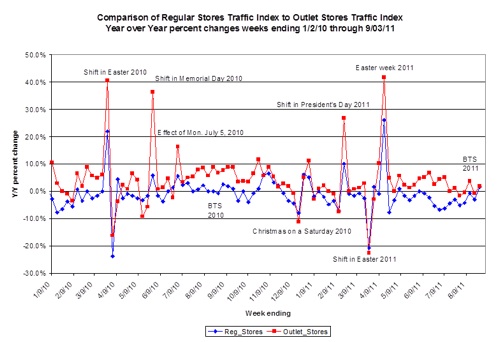Articles and News
EXCLUSIVE! SHOPPER TRAK SAYS 94% OF SHOPPING STILL IN-STORE, NAME AND RELATIONSHIP MATTER | October 19, 2011 (0 comments)

Chicago, IL—In the October 6 edition of The Centurion, we reported Shopper Trak’s latest findings that holiday traffic is likely to be a case of quality over quantity, marked by fewer feet in the door, but bigger purchases made by those who do come in. The group predicts a 3% rise in holiday sales across the board for 2011.
Shopper Trak is the world’s largest counter and analyzer of retail foot traffic. Using more than 40,000 video analytic devices, the firm counts and analyzes the behavior of more than 10 billion shopper-to-retailer visits per year.
Now, in an exclusive interview with The Centurion, Bill Martin, founder of Shopper Trak, explains this shift and other trends in luxury shopping that his firm has observed. Teresa Kruger, Shopper Trak’s director of media relations, also comments.
The Centurion: What are some of the shifts you’ve been observing in shopping behavior?
Bill Martin: {During the recession] we saw the flow of traffic ease downscale, to discounters. But in the last 18 months, it’s not fashionable to buy generic anymore. People want the label. They don’t want jeans from Walmart or Target, they want Lucky and other brand names. It’s also evidenced by sales of handbags and jewelry.
Centurion: Is it frugal fatigue or a return to luxury?
Martin: Another trend we’ve observed is that outlet malls seem to be gaining popularity, vs. regular retail. People don’t want to buy low-end, they want the better brand but at a value price.
Centurion: Are consumers aware that outlet merchandise often is manufactured specifically for the outlet, and it isn’t the same as the full retail line? Do they care?
Martin: I think customers are aware they aren’t getting the greatest selection at the outlet but they don’t seem to mind.

In this chart from ShopperTrak, the red line shows the percentage of change in traffic at outlet stores, while the blue shows the percentage of change for traffic at regular full-price retail stores. With few exceptions--mainly Christmas 2010 and Easter 2011--foot traffic at outlets has increased more than foot traffic at regular retail stores has.
Centurion: What trends are you seeing at full-price retail stores?
Martin: What we’re seeing is a difference in how people shop. Things like economic news and bad weather depress traffic, but people window shop online. They research in advance, then go to a specific store for a purpose. They’re not hanging out at the mall visiting dozens of stores; by the time they get to a store, they’re done [comparison shopping].
Centurion: So a jeweler or other retailer really needs to get to them first.
Martin: People who come in [to the store] are highly motivated to make a purchase, so you have to nurture the relationship to make the sale. The client can become your advocate, and they’re more likely to brag about their purchase on Facebook and so forth.
Teresa Kruger: The value still is in knowing your foot traffic. For example, if you’re planning to buy high-end jewelry, it’s not an impulse purchase unless you’re in trouble. So the retailer has to be certain to have the right people in place at the right time.
Centurion: How so?
Kruger: For example, one client thought that Friday nights and Sunday afternoons were their slowest time. But our devices showed the opposite was true.
Martin: We have high-end retailers who learned that end-of-day traffic is their highest time. One retailer was spending the time closing the store, when it was their biggest traffic time. By staying open one hour longer, they had a huge lift.
Centurion: But if people are window-shopping online first, aren’t they just buying online too?
Martin: 94% of commerce still takes place in the store. And for luxury goods, the five senses still need to be satisfied. Our view is that brick and mortar will be successful for a very long time, till they figure out how to engage the five senses online.
Kruger: Shopping channels need to complement each other, not be exclusive of each other. It’s all a matter of knowing what to do.







